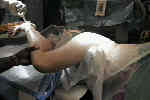




- Discussion:
- anesthesia considerations:
- note that with spinal anesthesia, the table will be tilted reverse trendelenburg inorder to prevent high spinal (this will have the effect
of predisposing for vertical cup position if note remedied;
- note that leg lengthening is more common with spinal vs general;
- foley catheter;
- anterior and posterior padded posts are placed to keep the patient in the lateral position;
- ensure that the anterior Montreal Post is place just above the ASIS, and that the patient is able to flex more than 90 deg;
- if the post is placed below the ASIS the patient's thigh will impinge on it as the hip is flexed (which results in incomplete hip flexion);
- incomplete hip flexion will not permit optimal clearance of the gluteus medius during femoral broaching (which means that an assistant must
retract the medius during broaching);
- incomplete hip flexion will cause to the hip to prematurely dislocate during the trial reduction;
- excessive tightness of the posts can impede vena cava flow which is manifested as a drop in BP prior to surgery;
- lateral position:
- in the lateral position, the pelvis may be flexed and may be adducted compared with the standing position;
- this may cause the acetabular component to be placed in less anteversion and more abduction than desired;
- one must insist on a true lateral position, inorder for the acetabulum to be properly reamed; (acetabular anteversion)
- be aware of "sway back" (hyperlordotic LS and pelvis), since this will tend to artificially increase cup anteversion during insertion;
- superior-inferior tilt:
- note that with spinal anesthesia, the anesthesiologist will often keep the table tilted down to ensure that there is not a high spinal;
- this position will induce the error of a verticle cup during reaming and insertion;
- hence, before prepping, ensure that the table is slightly tilted head down;
- if the patient's pelvis is positioned on a "bean bag", the torso may be tilted in a relative inferior position;
- this may have the effect of causing the pelvis to be reamed in an excessively verticle position;
- antero-posterior tilt:
- if the pelvis is tilted anteriorly (as happens when the operative side is flexed in front of the non operative side), there will be
a tendency to ream the pelvis in a retroverted position;
- also ensure that patient's back is toward the posterior edge of the table inorder to ensure that the operative leg can lie in front of
the non operative leg without falling off the table;
- padding:
- an axillary roll is positioned underneath the patient at the level of the nipples;
- the bottom leg should be padded w/ pillows to avoid peroneal nerve palsy;
- the bottom arm needs to be padded to avoid ulnar neuropathy;
- OR lights:
- position the OR lights prior to prepping;
- there is some evidence that the "sterile" OR light handles are a common source of contaminant during surgery, and ideally
these should not be touched during the case;
- Mayo stand:
- a padded Mayo stand at the foot of the table allows the leg to be internally rotated (assistant free);
Methods to Prevent Infection:
- prophylactic antibiotics:
- skin prep agents:
- Complications:
- acute tubular necrosis:
- may result from direct compression against the abdominal support post;
Acute tubular necrosis of an allograft kidney following total hip replacement. A case report.
Intraoperative pelvic motion in total hip arthroplasty.
Well-limb compartment syndrome after prolonged lateral decubitus positioning. A report of two cases.
Bacteriology swab in primary total hip arthroplasty-- does it have a role?

